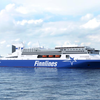Delivery of the fifth Super Post Panamax (SPP) Reggiane Crane on February 24th to the Port of Aden emphasizes its policy of phased expansion of container handling services to meet increasing demand. This additional crane, with the same 55m outreach as the first four delivered in 1999, will allow the Aden Container Terminal (ACT) to handle over 500,000 TEU, a figure that it soon expects to reach. Yard operations were expanded in 2001 by delivery of additional five RTG’s plus tractors and trailer units.
Aden has maintained an average annual container volume growth rate of over 40 percent during the past 9 years. Volume has risen from 121,600 TEU when the ACT opened in 1999 to over 377,000 in 2001, above 50 percent each year.
Almost 2,000 ships, not counting fishing vessels and yachts, called at Aden in 2001, compared with under 900 in 1995. The port took delivery of two conventional tugs in 1998 and has ordered a further two 60 tonne bollard pull ASD tugs from Damen shipyard for delivery in
September and November this year to handle its expanding traffic volume.
The Ma’alla Terminal, completed in 1990, now has very high levels of berth occupancy and, with a second silo and a flour mill complex due to open in April, new berths equipped to handle fully loaded bulk carriers of 80,000 TDW or better are included in the port’s immediate development plans. Non-container cargo growth has exceeded 250 percent since 1997, from 874,000 to over 2.2 million tonnes in 2001.
Further ahead the port will make much more extensive use of the almost 50 square kilometers of sheltered water lying between the Aden peninsula and the Little Aden refinery/Oil Harbor area as facilities are expanded.
The 1998 dredging program increased water depth in the 4km approach channel and 700 meter diameter inner harbor turning basin to 15m or better. With excellent sea bed stability, this can be increased to any required depth without any need for maintenance dredging.
It was noted in the 1999 survey that outer harbor depths clear of the channel are essentially the same as those recorded in the first harbor approaches survey – carried out in 1835.
Subscribe for
Maritime Reporter E-News
Maritime Reporter E-News is the maritime industry's largest circulation and most authoritative ENews Service, delivered to your Email five times per week










